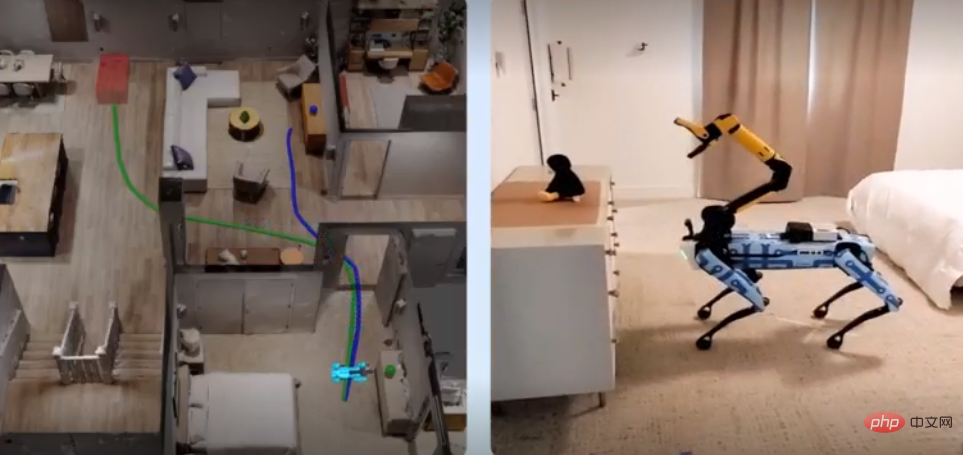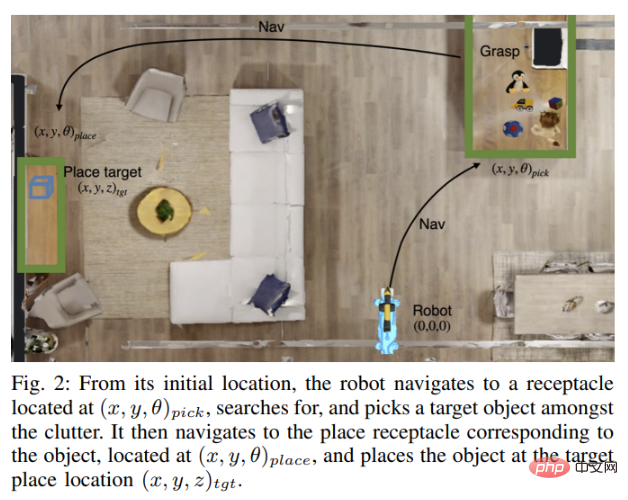 Technology peripherals
Technology peripherals
 AI
AI
 Meta researchers create artificial visual cortex that allows robots to operate visually
Meta researchers create artificial visual cortex that allows robots to operate visually
Meta researchers create artificial visual cortex that allows robots to operate visually

Researchers at Meta Corporation’s AI Research Department recently issued an announcement announcing key progress in robot adaptive skill coordination and visual cortex replication. They say these advances allow AI-powered robots to operate in the real world through vision and without needing to acquire any data from the real world.

They claim this is a major advance in creating general-purpose "Embodied AI" robots that can operate without human intervention. Interact with the real world. The researchers also said they created an artificial visual cortex called "VC-1" that was trained on the Ego4D dataset, which records daily activities from thousands of research participants around the world. video.
As the researchers explained in a previously published blog post, the visual cortex is the area of the brain that enables organisms to convert vision into movement. Therefore, having an artificial visual cortex is a key requirement for any robot that needs to perform tasks based on the scene in front of it.
Since the artificial visual cortex of "VC-1" is required to perform a range of different sensorimotor tasks well in a variety of environments, the Ego4D dataset plays a particularly important role as it contains research participants Users use wearable cameras to record thousands of hours of video of daily activities, including cooking, cleaning, exercising, crafting, and more.
The researchers said: "Biological organisms have a universal visual cortex, which is the embodiment agent we are looking for. Therefore, we set out to create a dataset that performs well in multiple tasks, with Ego4D as the core dataset, and improve VC-1 by adding additional datasets. Since Ego4D mainly focuses on daily activities such as cooking, gardening, and crafting, we also adopted a dataset of egocentric videos exploring houses and apartments."
However, the visual cortex is only one element of "concrete AI". For a robot to work fully autonomously in the real world, it must also be able to manipulate objects in the real world. The robot needs vision to navigate, find and carry an object, move it to another location, and then place it correctly—all actions it performs autonomously based on what it sees and hears.
To solve this problem, Meta’s AI experts teamed up with researchers at Georgia Tech to develop a new technology called Adaptive Skill Coordination (ASC), which the robots use to simulate training and then replicating these skills into real-world robots.
Meta also collaborated with Boston Dynamics to demonstrate the effectiveness of its ASC technology. The two companies combined ASC technology with Boston Dynamics' Spot robot to give its robot powerful sensing, navigation and manipulation capabilities, although it also requires significant human intervention. For example, picking an object requires someone to click on the object displayed on the robot's tablet.
The researchers wrote in the article: "Our goal is to build an AI model that can perceive the world from onboard sensing and motor commands through the Boston Dynamics API."
Spot Robot Testing was conducted using the Habitat simulator, a simulation environment built with HM3D and ReplicaCAD datasets containing indoor 3D scan data of over 1,000 homes. The Spot robot was then trained to move around a house it had not seen before, carrying objects and placing them in appropriate locations. The knowledge and information gained by the trained Spot robots are then replicated to Spot robots operating in the real world, which automatically perform the same tasks based on their knowledge of the layout of the house.

We used two very different real-world environments: a 185-square-meter fully furnished apartment and a 65-square-meter university laboratory. The Spot robot was tested, requiring it to relocate various items. Overall, the Spot robot with ASC technology performed nearly flawlessly, succeeding 59 times out of 60 tests, overcoming hardware instability, picking failures, and movement. Adversarial interference such as obstacles or blocked paths." Meta researchers said that they also opened the source code of the VC-1 model and shared how to scale the model size in another paper. Details on data set size, etc. In the meantime, the team's next focus will be trying to integrate VC-1 with ASC to create a more human-like representational AI system.
The above is the detailed content of Meta researchers create artificial visual cortex that allows robots to operate visually. For more information, please follow other related articles on the PHP Chinese website!

Hot AI Tools

Undresser.AI Undress
AI-powered app for creating realistic nude photos

AI Clothes Remover
Online AI tool for removing clothes from photos.

Undress AI Tool
Undress images for free

Clothoff.io
AI clothes remover

Video Face Swap
Swap faces in any video effortlessly with our completely free AI face swap tool!

Hot Article

Hot Tools

Notepad++7.3.1
Easy-to-use and free code editor

SublimeText3 Chinese version
Chinese version, very easy to use

Zend Studio 13.0.1
Powerful PHP integrated development environment

Dreamweaver CS6
Visual web development tools

SublimeText3 Mac version
God-level code editing software (SublimeText3)

Hot Topics
 1664
1664
 14
14
 1423
1423
 52
52
 1321
1321
 25
25
 1269
1269
 29
29
 1249
1249
 24
24
 How to use the chrono library in C?
Apr 28, 2025 pm 10:18 PM
How to use the chrono library in C?
Apr 28, 2025 pm 10:18 PM
Using the chrono library in C can allow you to control time and time intervals more accurately. Let's explore the charm of this library. C's chrono library is part of the standard library, which provides a modern way to deal with time and time intervals. For programmers who have suffered from time.h and ctime, chrono is undoubtedly a boon. It not only improves the readability and maintainability of the code, but also provides higher accuracy and flexibility. Let's start with the basics. The chrono library mainly includes the following key components: std::chrono::system_clock: represents the system clock, used to obtain the current time. std::chron
 How to understand DMA operations in C?
Apr 28, 2025 pm 10:09 PM
How to understand DMA operations in C?
Apr 28, 2025 pm 10:09 PM
DMA in C refers to DirectMemoryAccess, a direct memory access technology, allowing hardware devices to directly transmit data to memory without CPU intervention. 1) DMA operation is highly dependent on hardware devices and drivers, and the implementation method varies from system to system. 2) Direct access to memory may bring security risks, and the correctness and security of the code must be ensured. 3) DMA can improve performance, but improper use may lead to degradation of system performance. Through practice and learning, we can master the skills of using DMA and maximize its effectiveness in scenarios such as high-speed data transmission and real-time signal processing.
 How to handle high DPI display in C?
Apr 28, 2025 pm 09:57 PM
How to handle high DPI display in C?
Apr 28, 2025 pm 09:57 PM
Handling high DPI display in C can be achieved through the following steps: 1) Understand DPI and scaling, use the operating system API to obtain DPI information and adjust the graphics output; 2) Handle cross-platform compatibility, use cross-platform graphics libraries such as SDL or Qt; 3) Perform performance optimization, improve performance through cache, hardware acceleration, and dynamic adjustment of the details level; 4) Solve common problems, such as blurred text and interface elements are too small, and solve by correctly applying DPI scaling.
 What is real-time operating system programming in C?
Apr 28, 2025 pm 10:15 PM
What is real-time operating system programming in C?
Apr 28, 2025 pm 10:15 PM
C performs well in real-time operating system (RTOS) programming, providing efficient execution efficiency and precise time management. 1) C Meet the needs of RTOS through direct operation of hardware resources and efficient memory management. 2) Using object-oriented features, C can design a flexible task scheduling system. 3) C supports efficient interrupt processing, but dynamic memory allocation and exception processing must be avoided to ensure real-time. 4) Template programming and inline functions help in performance optimization. 5) In practical applications, C can be used to implement an efficient logging system.
 How to measure thread performance in C?
Apr 28, 2025 pm 10:21 PM
How to measure thread performance in C?
Apr 28, 2025 pm 10:21 PM
Measuring thread performance in C can use the timing tools, performance analysis tools, and custom timers in the standard library. 1. Use the library to measure execution time. 2. Use gprof for performance analysis. The steps include adding the -pg option during compilation, running the program to generate a gmon.out file, and generating a performance report. 3. Use Valgrind's Callgrind module to perform more detailed analysis. The steps include running the program to generate the callgrind.out file and viewing the results using kcachegrind. 4. Custom timers can flexibly measure the execution time of a specific code segment. These methods help to fully understand thread performance and optimize code.
 Quantitative Exchange Ranking 2025 Top 10 Recommendations for Digital Currency Quantitative Trading APPs
Apr 30, 2025 pm 07:24 PM
Quantitative Exchange Ranking 2025 Top 10 Recommendations for Digital Currency Quantitative Trading APPs
Apr 30, 2025 pm 07:24 PM
The built-in quantization tools on the exchange include: 1. Binance: Provides Binance Futures quantitative module, low handling fees, and supports AI-assisted transactions. 2. OKX (Ouyi): Supports multi-account management and intelligent order routing, and provides institutional-level risk control. The independent quantitative strategy platforms include: 3. 3Commas: drag-and-drop strategy generator, suitable for multi-platform hedging arbitrage. 4. Quadency: Professional-level algorithm strategy library, supporting customized risk thresholds. 5. Pionex: Built-in 16 preset strategy, low transaction fee. Vertical domain tools include: 6. Cryptohopper: cloud-based quantitative platform, supporting 150 technical indicators. 7. Bitsgap:
 Steps to add and delete fields to MySQL tables
Apr 29, 2025 pm 04:15 PM
Steps to add and delete fields to MySQL tables
Apr 29, 2025 pm 04:15 PM
In MySQL, add fields using ALTERTABLEtable_nameADDCOLUMNnew_columnVARCHAR(255)AFTERexisting_column, delete fields using ALTERTABLEtable_nameDROPCOLUMNcolumn_to_drop. When adding fields, you need to specify a location to optimize query performance and data structure; before deleting fields, you need to confirm that the operation is irreversible; modifying table structure using online DDL, backup data, test environment, and low-load time periods is performance optimization and best practice.
 How to use string streams in C?
Apr 28, 2025 pm 09:12 PM
How to use string streams in C?
Apr 28, 2025 pm 09:12 PM
The main steps and precautions for using string streams in C are as follows: 1. Create an output string stream and convert data, such as converting integers into strings. 2. Apply to serialization of complex data structures, such as converting vector into strings. 3. Pay attention to performance issues and avoid frequent use of string streams when processing large amounts of data. You can consider using the append method of std::string. 4. Pay attention to memory management and avoid frequent creation and destruction of string stream objects. You can reuse or use std::stringstream.



